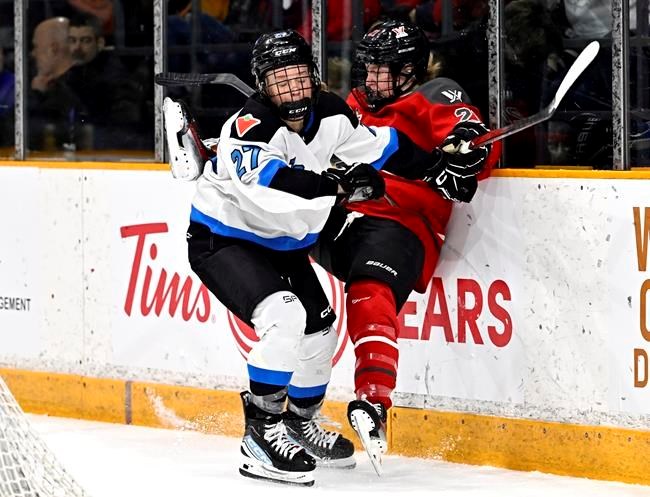UTICA, N.Y. — Coaches and players in the Professional Women's Hockey League don't expect the new league's brand of hard-hitting hockey to continue into the world championship.
The PWHL rule book released Jan. 1 and the International Ice Hockey Federation's 2023-24 rule book carry identical language around body checking in women's hockey, but similar to NHL players heading to the men's world championship, an adjustment is expected.
"It's definitely going to be refereed differently I think," said Canadian forward Brianne Jenner, who suits up for Ottawa in the PWHL. "There's going to be probably more of that kind of open-ice body contact being called for sure."
Canada opens the world championship Thursday evening against Finland, followed by Friday afternoon's meeting with Switzerland at the Adirondack Bank Center.
"Body checking" was once a called minor penalty in international women's hockey. Now, the term is "illegal hit." In its first season, the PWHL has provided a lot of leeway when it comes to full-body checks.
"Nobody's running around absolutely demolishing people out there in open ice," said Canadian and Toronto PWHL forward Sarah Nurse. "It's definitely a tough league and I think it's prepared us for the level of compete that we need.
"We may have to hold back a little bit, but I don't anticipate a big change."
The Swedish Women's Hockey League (SDHL) introduced body checking for the 2022-23 season. Almost 90 players in the 2024 world championship in Utica, N.Y., play in either the PWHL or SDHL.
"The reality is, in our sport, all calls are sort of discretionary calls, right? It's based on what people see and what they feel transpired," said Czechia and PWHL Ottawa head coach Carla MacLeod. "You're trying to black and white something that's so immensely grey.
"I think we'll learn quickly here. All these women have trained so hard to be here, I hope we get the chance to play competitive five-on-five hockey."
IIHF officiating has traditionally been stricter around checking in both the men's and women's game.
"The officials and how they'll call it, they're not going to call it the way the PWHL is called," said Canadian and PWHL Toronto head coach Troy Ryan.
"An athlete that plays in the PWHL is going to be going into this world championship and the first question they're going to say 'is it going to be called the same way that it's called in the PWHL?' The answer is no for sure.
"Any good team needs to adjust to that. It can't be an excuse. If it is, you don't deserve the success you're looking for."
IIHF women's world championship chair Marta Zawadzka of Poland says all the teams were contacted a month before the tournament started, and were provided video examples of officiating standards.
"The message is to play the puck," she said. "As long as your first thing is to play the puck, not the opponent, that's the biggest interpretation.
"When you are hitting an opponent … and have no intention to play the puck, you've got bigger strength and speed and you can see the first purpose is the opponent, then you need to call it because it's dangerous. It's reckless."
An IIHF challenge is applying a common officiating standard to lower-division world championships involving 33 other countries, outside the top-tier tournament that includes Canada.
"We are responsible for all levels," Zawadzka said. "In the women's game, you have sometimes (a) difference in the physicality. We need to have that as well in mind, especially in the lower divisions. It might have a bigger impact than here."
PWHL and IIHF rules both state body checking is allowed when there is a "clear intention of playing the puck or attempting to gain possession of the puck."
As long as two opposing players pursue the puck they can "reasonably" push and lean into each other, but they can't use the boards to pin, push or eliminate each other from puck pursuit.
A stationary player is entitled to that area, and it's up to the opponent to avoid body contact, the rule books say.
If a puck carrier is skating at a stationary player, it's the puck carrier's duty to avoid contact, but an opponent moving into the puck carrier is assessed an illegal hit penalty.
No player is required to move out of the way of an oncoming player to avoid a collision. Any move by a player to step or glide into an opposing player should be called for an illegal hit.
"I think it will be a tighter game here. I think it's going to be extremely strict," said U.S. and PWHL Boston forward Hilary Knight. "There should be a little bit more ice to move in out there. I think everyone is going to have to adjust their game.
"It's the same as when the NHL guys are playing NHL rules and they go to world championships and now they're playing IIHF rules."
This report by The Canadian Press was first published April 3, 2024.
Donna Spencer, The Canadian Press
